

DVB. Official DVB logo, found on compliant devices Digital Video Broadcasting (DVB) is a suite of internationally accepted open standards for digital television.
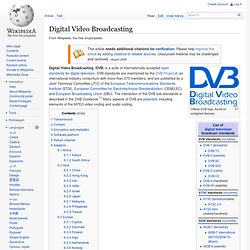
DVB standards are maintained by the DVB Project, an international industry consortium with more than 270 members, and are published by a Joint Technical Committee (JTC) of the European Telecommunications Standards Institute (ETSI), European Committee for Electrotechnical Standardization (CENELEC) and European Broadcasting Union (EBU). The interaction of the DVB sub-standards is described in the DVB Cookbook.[1] Many aspects of DVB are patented, including elements of the MPEG video coding and audio coding. Transmission[edit] DVB systems distribute data using a variety of approaches, including: These standards define the physical layer and data link layer of the distribution system.
These distribution systems differ mainly in the modulation schemes used and error correcting codes used, due to the different technical constraints. ATSC. 위키백과, 우리 모두의 백과사전.

VCT. In most telecommunications organizations, a virtual channel, is a method of remapping the program number as used in H.222 Program Association Tables and Program Mapping Tables to a channel number that can be entered via digits on a receiver's remote controller.
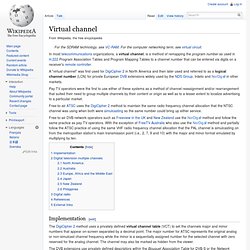
A "virtual channel" was first used for DigiCipher 2 in North America and then later used and referred to as a logical channel number (LCN) for private European DVB extensions widely used by the NDS Group, Irdeto and NorDig in other markets. Pay TV operators were the first to use either of these systems as a method of channel reassignment and/or rearrangement that suited their need to group multiple channels by their content or origin as well as to a lesser extent to localize advertising to a particular market. Free-to-air ATSC uses the DigiCipher 2 method to maintain the same radio frequency channel allocation that the NTSC channel was using when both were simulcasting so the same number could bring up either service. Japan[edit] Advanced Audio Coding. Advanced Audio Coding (AAC) is a standardized, lossy compression and encoding scheme for digital audio.

Designed to be the successor of the MP3 format, AAC generally achieves better sound quality than MP3 at similar bit rates.[2] NTSC. FCC. The FCC was formed by the Communications Act of 1934 to replace the radio regulation functions of the Federal Radio Commission.

The FCC took over wire communication regulation from the Interstate Commerce Commission. The FCC's mandated jurisdiction covers the 50 states, the District of Columbia, and U.S. possessions. The FCC also provides varied degrees of cooperation, oversight, and leadership for similar communications bodies in other countries of North America. The FCC is funded entirely by regulatory fees. It has an estimated fiscal-2011 budget of US$335.8 million and a proposed fiscal-2012 budget of $354.2 million. Mission and strategy[edit] Consistent with the objectives of the Act as well as the 1993 Government Performance and Results Act (GPRA), the FCC has identified six goals in its 2006–2011 Strategic Plan.
Broadband "All Americans should have affordable access to robust and reliable broadband products and services. Competition Spectrum. Title 47 CFR Part 15. Subparts[edit] A - General[edit] Subpart A includes 21 sections from 15.1 to 15.38. 47 C.F.R. 15.1b states that any radiator (that which emits radio energy), whether or not intentional, must be licensed unless it meets 47 CFR 15 or is otherwise exempted by the FCC.
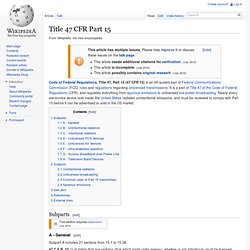
Parental controls. Parental controls are features which may be included in digital television services, computer and video games, mobile devices and software.
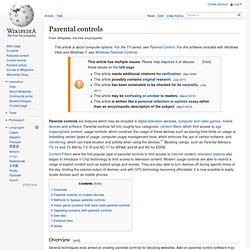
Parental controls fall into roughly four categories: content filters, which limit access to age inappropriate content; usage controls, which constrain the usage of these devices such as placing time-limits on usage or forbidding certain types of usage; computer usage management tools, which enforces the use of certain software; and, monitoring, which can track location and activity when using the devices.[1] Blocking ratings, such as Parental Advisory, TV-14 and TV-MA for TV, R and NC-17 for MPAA, and M and AO for ESRB. Content Filters were the first popular type of parental controls to limit access to Internet content. television stations also began to introduce V-Chip technology to limit access to television content. Television content rating systems. Television content rating systems give viewers an idea of the suitability of a television program for children or adults.
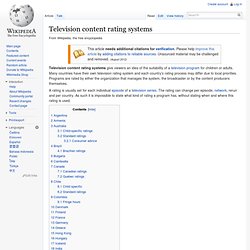
Many countries have their own television rating system and each country's rating process may differ due to local priorities. Programs are rated by either the organization that manages the system, the broadcaster or by the content producers themselves. A rating is usually set for each individual episode of a television series. The rating can change per episode, network, rerun and per country. V-chip. V-chip is a generic term for technology used in television set receivers in Canada, Brazil and the USA, which allows the blocking of programs based on their ratings category.
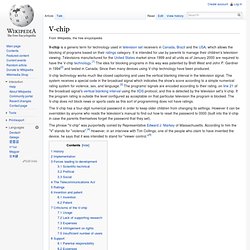
It is intended for use by parents to manage their children's television viewing. Televisions manufactured for the United States market since 1999 and all units as of January 2000 are required to have the V-chip technology.[1] The idea for blocking programs in this way was patented by Brett West and John P. Gardner in 1994[2] and tested in Canada. Motion picture rating system. A motion picture rating system is designated to classify films with regard to suitability for audiences in terms of issues such as sex, violence, substance abuse, profanity, impudence or other types of mature content.
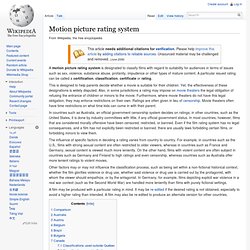
A particular issued rating can be called a certification, classification, certificate or rating. This is designed to help parents decide whether a movie is suitable for their children.